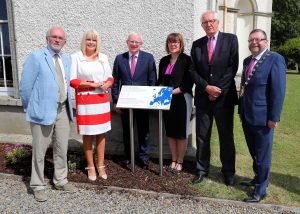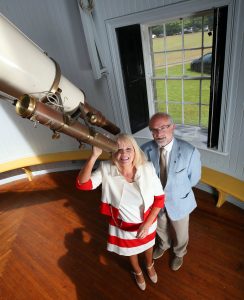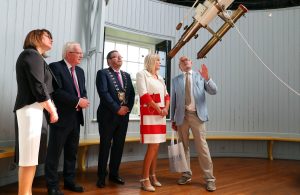
Dunsink Observatory, part of the Dublin Institute for Advanced Studies (DIAS), sealed its status as one of Ireland’s most important scientific sites today (23.06.18), when it was recognised by the European Physical Society as a “site of historical significance”.
The Observatory is the first location in Ireland to receive this accolade, joining similarly significant locations across Europe, such as Einstein’s house in Bern and Marie Skłodowska Curie’s laboratory in Paris.
A plaque to commemorate the designation was unveiled at Dunsink Observatory today (23.06.18) by Mary Mitchell O’Connor TD, Minister of State for Higher Education, and Professor Rüdiger Voss, President of the European Physical Society.
Legacy of William Hamilton
 Dunsink Observatory was selected by the European Physical Society as a site of historical significance in recognition of the genius of Sir William Rowan Hamilton, who lived and worked at Dunsink from 1827 until his death in 1865.
Dunsink Observatory was selected by the European Physical Society as a site of historical significance in recognition of the genius of Sir William Rowan Hamilton, who lived and worked at Dunsink from 1827 until his death in 1865.
Considered Ireland’s greatest ever mathematician, Hamilton contributed to the development of optics, dynamics and algebra, discovering the algebra of quaternions. His work had a significant influence on the development of quantum mechanics, and the Hamiltonian circuits in contemporary graph theory are named in his honour.
Dunsink Observatory now functions primarily as an outreach centre, attracting over 4,000 visitors a year. It has been part of DIAS since 1947.
Commenting at today’s plaque unveiling today, Dr. Eucharia Meehan, CEO and Registrar of DIAS, said: “It is a huge honour for DIAS to have Dunsink Observatory designated as Ireland’s first site of historical significance by the European Physical Society.
“Ireland has a rich history when it comes to mathematics, astronomy and the advancement of knowledge. In the 1700s and 1800s, we were at the forefront of the movement seeking to better understand our universe through mapping the sun, moon, stars, planets and other non-Earthly bodies.
“This accolade from the European Physical Society recognises the impact William Hamilton had on mathematics and astronomy. It is a fitting testament to his legacy.
“In an interesting connection, the Hamiltonian is a fundamental part of the Schrödinger equation, Professor Schrodinger being the first director of Theoretical Physics at DIAS during the 1940s and 1950s.
“We are delighted to have leading academics in DIAS to this day, who are continuing to build on the work of such luminaries as Hamilton and Schrödinger.”
 Summer School and Retirement of Professor Luke Drury
Summer School and Retirement of Professor Luke Drury
Today’s plaque unveiling took place against the backdrop of the DIAS Summer School in High Energy Astrophysics, which has been running throughout this week. Over 80 delegates from 16 countries have been attending the school.
Attendees include Xavier Barcons, Director-General of the European Southern Observatory, Joseph Silk Homewood, Professor of Physics and Astronomy at Johns Hopkins, and Marica Branchesi, Assistant Professor at the Gran Sasso Science Institute, who was named on the “2018 TIME 100”, its annual list of the 100 most influential people in the world.
The programme of events at DIAS today also included a ceremony to mark the retirement of Professor Luke Drury, outgoing Head of Astronomy and Astrophysics at DIAS.
One of Ireland’s most accomplished astrophysicists, Professor Drury specialises in particle theory and interstellar gas dynamics. In addition to his research on diffusive shock acceleration theory and its applications, he has been active in building up the Irish national computational research infrastructure and is a member of the Scientific Steering Committee of PRACE, the pan-European supercomputing consortium.
He has also served extensively on the advisory structures of the European Space Agency and was chair of its Astronomy Working Group from 2014 to 2017. He was elected a Member of the Royal Irish Academy in 1995 and served as International Relations Secretary from 2003 to 2006 and as President from 2011 to 2014. He was elected to membership of the Academia Europea in 2005.
Commenting on his retirement, Professor Vincent Cunnane, Chair of the Council of DIAS, said: “Luke Drury has demonstrated exemplary commitment to DIAS and to the advancement of science in Ireland and internationally.
“He is an accomplished academic with his research in diffusive shock acceleration theory and its applications, and an excellent colleague, selflessly sharing his knowledge and time to ensure future generations will continue his work at DIAS and beyond. Most notably, he has also been an ambassador for Irish science internationally and has done Ireland some service.”
ENDS
For further information, contact: Eva Dowling / Niamh Breathnach Alice PR & Events. Tel: 01-5582151 / 083-1496045 / 085-1461231, email: media@alicepr.com
Notes to Editors:
About DIAS
DIAS was founded by Éamon de Valera in 1940 as a centre of excellence for advanced scholarship focused on three disciplines: Celtic Studies, Theoretical Physics and Cosmic Physics (encompassing Astronomy/Astrophysics and Geophysics). As the world’s second, and the Ireland’s only, Institute for Advanced Studies, it is a globally embedded institution which attracts scholars and academics from around the world. It conducts and publishes advanced research, and also leads Ireland’s participation in a number of international research endeavours which focus on big unanswered questions for mankind. Dunsink Observatory is part of DIAS and DIAS coordinates a range of national initiatives on behalf of government. Further information is available at www.dias.ie.
Follow DIAS on social media:
23rd June 2018: Dunsink Observatory designated Ireland’s first European site of historical significance
Leave a Comment
Last Updated: 3rd September 2018 by mary
Dunsink Observatory, part of the Dublin Institute for Advanced Studies (DIAS), sealed its status as one of Ireland’s most important scientific sites today (23.06.18), when it was recognised by the European Physical Society as a “site of historical significance”.
The Observatory is the first location in Ireland to receive this accolade, joining similarly significant locations across Europe, such as Einstein’s house in Bern and Marie Skłodowska Curie’s laboratory in Paris.
A plaque to commemorate the designation was unveiled at Dunsink Observatory today (23.06.18) by Mary Mitchell O’Connor TD, Minister of State for Higher Education, and Professor Rüdiger Voss, President of the European Physical Society.
Legacy of William Hamilton
Considered Ireland’s greatest ever mathematician, Hamilton contributed to the development of optics, dynamics and algebra, discovering the algebra of quaternions. His work had a significant influence on the development of quantum mechanics, and the Hamiltonian circuits in contemporary graph theory are named in his honour.
Dunsink Observatory now functions primarily as an outreach centre, attracting over 4,000 visitors a year. It has been part of DIAS since 1947.
Commenting at today’s plaque unveiling today, Dr. Eucharia Meehan, CEO and Registrar of DIAS, said: “It is a huge honour for DIAS to have Dunsink Observatory designated as Ireland’s first site of historical significance by the European Physical Society.
“Ireland has a rich history when it comes to mathematics, astronomy and the advancement of knowledge. In the 1700s and 1800s, we were at the forefront of the movement seeking to better understand our universe through mapping the sun, moon, stars, planets and other non-Earthly bodies.
“This accolade from the European Physical Society recognises the impact William Hamilton had on mathematics and astronomy. It is a fitting testament to his legacy.
“In an interesting connection, the Hamiltonian is a fundamental part of the Schrödinger equation, Professor Schrodinger being the first director of Theoretical Physics at DIAS during the 1940s and 1950s.
“We are delighted to have leading academics in DIAS to this day, who are continuing to build on the work of such luminaries as Hamilton and Schrödinger.”
Today’s plaque unveiling took place against the backdrop of the DIAS Summer School in High Energy Astrophysics, which has been running throughout this week. Over 80 delegates from 16 countries have been attending the school.
Attendees include Xavier Barcons, Director-General of the European Southern Observatory, Joseph Silk Homewood, Professor of Physics and Astronomy at Johns Hopkins, and Marica Branchesi, Assistant Professor at the Gran Sasso Science Institute, who was named on the “2018 TIME 100”, its annual list of the 100 most influential people in the world.
The programme of events at DIAS today also included a ceremony to mark the retirement of Professor Luke Drury, outgoing Head of Astronomy and Astrophysics at DIAS.
One of Ireland’s most accomplished astrophysicists, Professor Drury specialises in particle theory and interstellar gas dynamics. In addition to his research on diffusive shock acceleration theory and its applications, he has been active in building up the Irish national computational research infrastructure and is a member of the Scientific Steering Committee of PRACE, the pan-European supercomputing consortium.
He has also served extensively on the advisory structures of the European Space Agency and was chair of its Astronomy Working Group from 2014 to 2017. He was elected a Member of the Royal Irish Academy in 1995 and served as International Relations Secretary from 2003 to 2006 and as President from 2011 to 2014. He was elected to membership of the Academia Europea in 2005.
Commenting on his retirement, Professor Vincent Cunnane, Chair of the Council of DIAS, said: “Luke Drury has demonstrated exemplary commitment to DIAS and to the advancement of science in Ireland and internationally.
“He is an accomplished academic with his research in diffusive shock acceleration theory and its applications, and an excellent colleague, selflessly sharing his knowledge and time to ensure future generations will continue his work at DIAS and beyond. Most notably, he has also been an ambassador for Irish science internationally and has done Ireland some service.”
ENDS
For further information, contact: Eva Dowling / Niamh Breathnach Alice PR & Events. Tel: 01-5582151 / 083-1496045 / 085-1461231, email: media@alicepr.com
Notes to Editors:
About DIAS
DIAS was founded by Éamon de Valera in 1940 as a centre of excellence for advanced scholarship focused on three disciplines: Celtic Studies, Theoretical Physics and Cosmic Physics (encompassing Astronomy/Astrophysics and Geophysics). As the world’s second, and the Ireland’s only, Institute for Advanced Studies, it is a globally embedded institution which attracts scholars and academics from around the world. It conducts and publishes advanced research, and also leads Ireland’s participation in a number of international research endeavours which focus on big unanswered questions for mankind. Dunsink Observatory is part of DIAS and DIAS coordinates a range of national initiatives on behalf of government. Further information is available at www.dias.ie.
Follow DIAS on social media:
Category: DIAS, News
Recent Posts
DIAS Astrophotography competition goes mobile for 2024
Irish scientists are part of groundbreaking discovery with James Webb Space Telescope
Dr Pauline Gagnon (formerly of CERN) to deliver two talks at DIAS
DIAS Professor announced as next President of the European Southern Observatory’s Council
Quake Shake: New programme encourages people to get involved in monitoring earthquakes
Language switcher